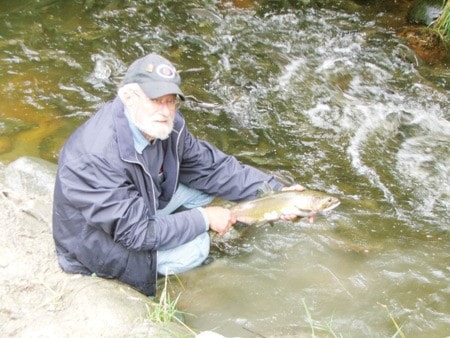Tales of salmon so abundant in B.C. rivers that you could walk across their backs are long over, but thanks to the decades long efforts by the Nile Creek Enhancement Society (NCES) the river in the community of Qualicum Bay is once again running with pink salmon and cutthroat trout.
The restoration of Nile Creek is the Society’s flagship project and for proof that the creek is almost in a pristine state, all one has to do is have a look at the stream.
Currently it is teeming with spawning salmon and people are in hip waders fly fishing at the mouth of the creek.
“I’ve seen it happen. Thngs were dead, the fish were gone, but there’s been a change,” recounts Carolyn Graeme, owner of Shady Shores Beach Resort in Bowser.
“I tell people you can now fish from your doorstep because you literally can. You can strap on your hip waders, walk out in to the ocean and start fly fishing. The fish are back,” she said.
It wasn’t a freak act of nature or magic that has seen Nile Creek start to approach the kind of productivity it once enjoyed. It was hard work by NCES volunteers and president Ken Kirkby said after 20 years of restoration work they feel pretty good about the outcome.
“We knew that to be successful we’d have to work from mountain to ocean to restore the habitat. We have proven it can be done and it is repeatable and hopefully this can serve as a model for other projects,” he said.
Kirkby said 20 years ago it was a dead river but they have brought it back to a full living system.
“The pink salmon were virtually gone. There wasn’t a single one.”
He said they began by putting incubators in the river and it was working quite well. But no sooner had they got things back on track again when they had a major setback with construction of the Inland Island Highway.
“In 1997 silt and debris from a sand slide, caused by construction of the new Inland Highway smothered the existing fry,” he recalled.
“The river, which was just back in business again, was smothered by a vast tonnage of silt and debris. It suffocated everything in the river and all the eggs. We decided that it would take too many years for nature to flush that material out into the sea and that the only alternative was to build a river adjacent to the river called a side channel.”
He said a 700 metre side channel was built with a donation from the Steelhead Society and a settlement with the Department of Highways.
“Over the years we put in hatcheries and infrastructure to accomplish what has been accomplished. It has led to considerable notice and has attracted universities and scientists.
“Now we have taken over six new rivers and estuaries,” he said.
“This channel still remains valuable habitat for spawning salmon and we are telling the story far and wide, through a major publication of a book.”
He said they are also making a movie on the project which is being shot now.
“We have been at it for a year and will be at it for a while yet. We are now in the last stages of making a trailer, which we intend to take to Germany.”
The film will then travel the world from country to country and Kirkby said when it has done the grand circuit it will come home to Canada.
“With the team we have on hand and those who wish to come and join us and the various institutions that have sided heavily with us, I think we have a good chance of doing what was once impossible.”
Work by volunteers at the Nile Creek Hatchery is about to kick into full gear.
Kirkby said they are currently taking eggs every few days from the Quinsam River Hatchery in Campbell River.
This is where they get their brood stock.
“We are not taking from our own fish yet. We want to get as many fish in the river as possible and over time in the future we will take the eggs ourselves from our own source.”
The fertilized eggs will reside at the Quinsam River Hatchery until they are ready to be transported, at which time a million and a half plus eggs in trays will be delivered to the Nile Creek Hatchery.
“In about a month we will pick eggs on a daily basis because the dead eggs will get fungus and that fungus spreads quickly and will kill everything if you let it,” he said. “So every day we have people who come with tweezers and pick the dead ones out and count every single dead thing so that we know what the survival rate is.”
He said over last number of years their survival rate has been around 98 per cent.
Over the winter about 40 people on a rotating basis will hand-feed the fish during daylight hours.
“It has to be by hand because these salmon are so tiny that normal feeders for larger fish don’t work. We have to feed them dust, but on a damp day the dust clogs up. We have a willing contingent of people lined up to feed the fish,” he admitted.
Kirkby said when the fish died 20 years ago, everything went away but now the future is looking bright for everyone in the community.
“When our pinks come home, the B&Bs are full, the pub does business, restaurants are full and people are making a better living. Now VIU is going to do an economic study of the value of Nile Creek to the community. It is a happy story in a sorry world.”
